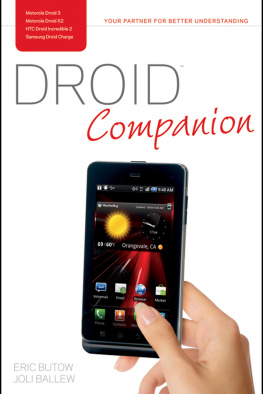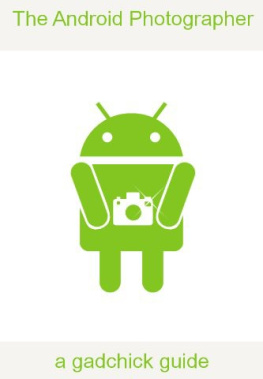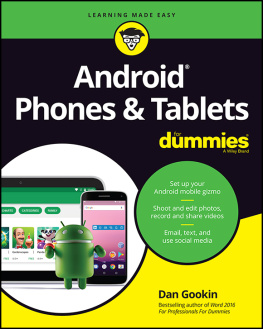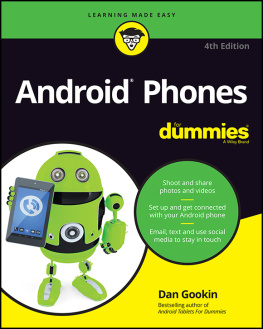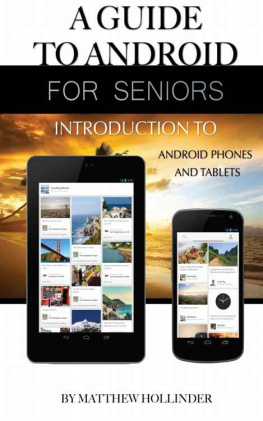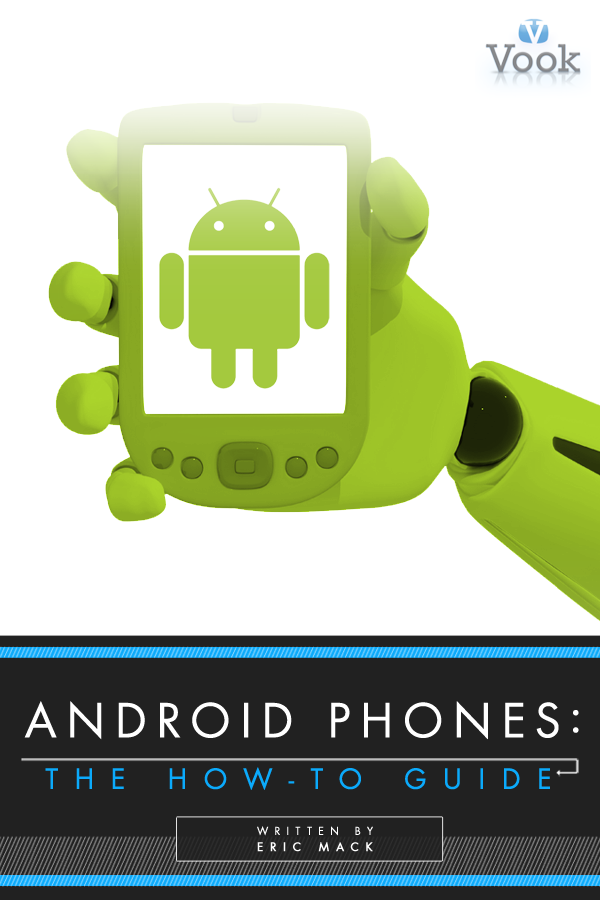Credits & Copyright
Author Profile:
Eric Mack - Eric Mack is a writer, blogger, and radio producer who covers technology, politics, energy, and the environment. A regular contributor to National Public Radio programs and former AOL editor, he has covered mobile and other technologies since the Web 1.0 days. A rare rural geek, he lives in the mountains of Northern New Mexico, where cell signals are often weak, just to make things more challenging.
Web Links:
- Author's Website
- Author's Twitter
Android Phones: The How-To Guide
by Eric Mack
Android has officially taken over the mobile world! But what IS Android and how can you make it work for you? With Android Phones: The How-To Guide youll learn about the history of Droid, the key players in the market, how to navigate your device, and how to get the most out of popular apps and features. In eight chapters youll learn how to use multitasking capabilities, search functions, GPS navigation, music, video and photo media, and more. Discover the different models of Android phones, and how to navigate each one. Youll also get familiar with call and contact management and notifications. Finally, this Vook will show you how to troubleshoot when you hit a roadblock with your Droid phone.
Copyright 2011 Vook, Inc.
Compilation copyright 2011 Vook, Inc.
Vook is a registered trademark of Vook, Inc.
Google's Android "Robot" image used pursuant to a creative commons license granted by Google Inc. This product is not endorsed by Google Inc.
Chapter 1
An Introduction to Android
I f youre reading this, chances are youve at least heard of Android, one of the fastest-growing operating systems for smartphones. By the end of 2010, it was crowned the best-selling mobile OS worldwide. This chapter looks at what it is, how it got started, and what sets it apart from the pack.
What is Android?
Android is a free, open-source mobile operating system available on a variety of smartphones from different manufacturers and on a few devices in the nascent tablet market. Although the development of Android has been largely spearheaded by online info giant Google and other major tech players, its based on the Linux kernel, one of the most notable pieces of free, open-source software. Androids accessibility is what sets it apart from other major smartphone players like Apple and Blackberry; while the competition puts walls around their wireless kingdoms, Android throws open the doors, allowing tens of thousands of developers to develop hundreds of thousands of available apps, creating limitless possibilities for what each Android-powered device can do.
DID YOU KNOW?
While Apples iPad currently dominates worldwide tablet sales (boasting a 90-percent share of the market), some analysts expect that Android-based tabs will begin to outsell Apple by 2015.
Android History
- 2003: A small start-up, Android, Inc., is incorporated.
- 2005: Google purchases Android.
- 2007: Google, Motorola, T-Mobile, Sprint, Samsung, Intel, and other big names form the Open Handset Alliance to catapult development of Android forward.
- 2008: T-Mobile G1 becomes the first Android-powered device available through a major carrier.
- October 2009: First Motorola Android devices released, including the Droid, first Android phone on the Verizon network.
- January 2010: A misstep as the Android-based Nexus One by HTC is released and sold directly through Google unlocked (not restricted to a single carrier). Following some technical issues and widespread criticism about Googles customer support, the Nexus One was discontinued in July of the same year.
- December 2010: Samsung Galaxy S Tablet running Android released to lackluster reviews; Android overtakes Apple and Nokia in worldwide mobile OS sales.
- 2011: Android updates to new version 3.0, redesigned specifically with tablets in mind.
What Makes Android Different?
- Its Openness: Unlike Apples strict approval protocol for iPhone apps, the open nature of Android and ready availability of tools to help app developers means the potential app library for Android is exploding.
- It's Customizable: Android apps can access any of a devices core features like calling, texting, and GPS, adding to the power of the platform.
- It's Built for Multitasking: One of Androids big improvements over the iPhone is its ability to smoothly run numerous applications at once, performing small tasks in the background, or switching back and forth between tasks just as you might on a laptop.
- It's Integrated for Google/Search Options: Android is fully integrated with Googles galaxy of services, and Googles top-notch search technology makes it simple to search email, files, the web, and just about anything else with a few taps.
HINT
Android is designed to fully integrate the online experience with the wireless experience. Pull up one of your contacts on your phone, and you can also see their email, current Facebook status, location, and much more.
Chapter 2
The Android Players
T he open nature of Android also means a larger field of players are getting in on the action when compared to other mobile operating systems. Not surprisingly, many of the most active companies in the Android scene are part of the Open Handset Alliance that formed in 2007 to collaborate on the Android project.
Google has been the single largest driving force behind Android since purchasing the tiny corporation in 2005. Google added the start-ups co-founder, Andy Rubin, to the Mountain View team to continue leading Androids development. The current Android OS leverages many of Googles strengths, such as:
- A powerful search capability that meshes well with almost any smartphone function.
- Fully integrated GPS navigation through Google Maps.
- An overall method for organization of information from numerous sources that makes an Android device one of the most potentially powerful devices ever to fit in your palm.
VOICES
Our vision is that the powerful platform we're unveiling will power thousands of different phone models." Then Google CEO Eric Schmidt in 2007, responding to rumors of a Google phone by announcing the development of the Android OS by the Open Handset Alliance.
Among handset manufacturers, Motorola has been leading the charge in the Android revolution. The companys Droid phone, released in 2009, was the first to run Android 2.0, and was followed by the Droid X, Droid 2, Droid 2 Global and, in February 2011, the XOOM, one of the first tablets to run Android 3.0, AKA Honeycomb. Honeycomb is the first incarnation of Android specifically designed with tablets in mind.
Aside from the Droid series, other popular Motorola Android devices include:
- Motorola Citrus.
- Motorola Cliq & Cliq-2.
- Motorola Bravo.
- Motorola Flipside.
- Motorola Flipout.
- Motorola Defy.
- Motorola Charm.
Motorola is literally betting the company on Android. At the beginning of 2011, the company completed the process of splitting itself in half, forming Motorola Mobility, a stand-alone company focused on handsets, most of them powered by Android.
HTC seems to be just as excited about Android as Motorola. The company was the first to launch a commercially available Android phone with the Dream in October 2008. Google also worked with HTC on its Nexus One phone. Other Android hits scored by HTC include:

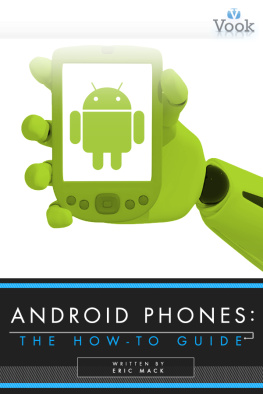

![Hart-Davis - Teach yourself visually Android phones and tablets, [2015]](/uploads/posts/book/212223/thumbs/hart-davis-teach-yourself-visually-android-phones.jpg)
